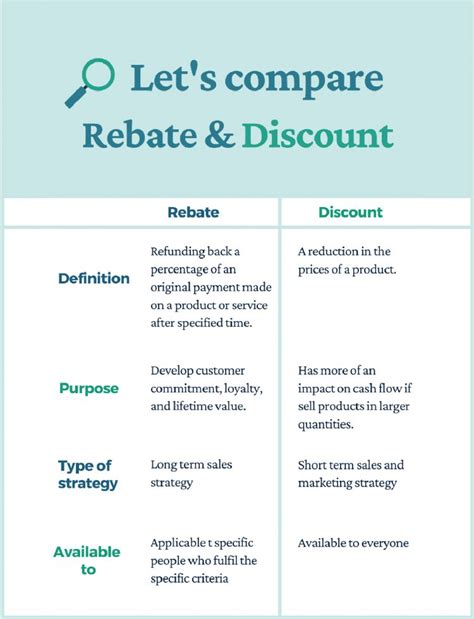In today’s consumer-driven market, rebates have emerged as a popular tool for saving money. They offer a way for businesses to encourage purchases and for consumers to enjoy discounts on products they want. This article will explore the concept of rebates, how they work, their benefits, and some important considerations for consumers.
What Are Rebates?
A rebate is a refund or discount applied to a consumer’s purchase. Unlike traditional discounts, where the price is reduced at the point of sale, rebates require consumers to pay the full price upfront and then request their money back afterward. Rebates can take various forms, including cash back, store credit, or gift cards.
How Rebates Work
The process of receiving a rebate generally involves several steps:
- Purchase the Product: The consumer buys a product that has a rebate offer attached to it.
- Obtain and Submit the Rebate Form: After making a purchase, consumers must fill out a rebate form, which can often be found on the retailer’s or manufacturer’s website or included with the product packaging.
- Provide Proof of Purchase: Consumers usually need to provide proof of purchase, such as a receipt or barcode, along with the rebate form.
- Wait for Processing: Once the rebate request is submitted, there is typically a processing time, which can range from a few weeks to several months.
- Receive the Rebate: Finally, the consumer will receive their rebate, usually in the form of a check, direct deposit, or digital payment method.
Types of Rebates
Rebates can be categorized into different types, each serving a specific purpose:
- Manufacturer Rebates: These are offered by the product manufacturer and can often be used at any retailer that sells the product.
- Retailer Rebates: Offered directly by retailers, these rebates are specific to purchases made within their stores.
- Mail-in Rebates: These require consumers to send a form and proof of purchase via mail to receive their rebate.
- Instant Rebates: Unlike mail-in rebates, these are applied immediately at the point of sale. The consumer pays the discounted price right away.
Benefits of Rebates
Rebates serve several purposes and come with numerous benefits for both consumers and businesses:
- Cost Savings: The primary benefit for consumers is the opportunity to save money on their purchases.
- Encouragement to Try New Products: Consumers may be more willing to try new products if they know a rebate is available.
- Increased Sales for Businesses: Rebates can encourage consumers to purchase more products, boosting sales volumes.
- Marketing Tool: Businesses can use rebates as a marketing strategy to attract new customers and maintain existing ones.
Considerations for Consumers
While rebates can offer great savings, there are important factors consumers should keep in mind:
- Expiration Dates: Rebates often come with tight deadlines for submission, so consumers need to be mindful of when they need to submit their rebate forms.
- Complexity: The process for obtaining rebates can be time-consuming and complex, sometimes involving multiple steps, which might discourage people from actually claiming them.
- Potential for Denial: There is a risk that rebate submissions could be denied due to minor errors in the application process, so accuracy is crucial.
- Delayed Gratification: Since rebates are not given immediately, some consumers may find it frustrating to wait for their savings.
Tips for Maximizing Rebates
To make the most of rebate offers, consumers can follow these tips:
- Read the Fine Print: Always examine the rebate offer carefully to understand all terms, conditions, and deadlines.
- Keep Records: Save receipts and a copy of submitted rebate forms to avoid potential issues later on.
- Plan Purchases: Consider timing your purchases around rebate offers to maximize savings, especially during sales events.
- Use Apps and Websites: Leverage technology to find rebates and keep track of submissions. There are many apps available that can help you stay organized and informed.
Conclusion
Rebates can be a valuable tool for consumers looking to save money, but they require attention and effort to realize those savings fully. By understanding how rebates work, what types are available, and the best practices for claiming them, savvy shoppers can improve their purchasing decisions and maximize their financial returns.
FAQs
1. Are rebates the same as discounts?
No, rebates and discounts are different. A discount reduces the price at the point of sale, while a rebate involves paying the full price upfront and receiving a refund later.
2. How long does it take to receive a rebate?
The processing time for rebates can vary, typically ranging from a few weeks to several months, depending on the retailer or manufacturer’s policies.
3. Can rebates expire?
Yes, rebates often have expiration dates, requiring consumers to submit their rebate requests within a specified timeframe.
4. What should I do if my rebate is denied?
If your rebate claim is denied, review the submission for errors, gather your proof of purchase, and contact the customer service department of the retailer or manufacturer for clarification and potential resolution.
5. Can I combine multiple rebates on the same purchase?
It depends on the terms of each rebate. Some rebates allow stacking, while others may state that only one rebate can be applied per purchase. Always review the specific terms before submitting.
This article provides a comprehensive overview of rebates, their types, benefits, and offers practical tips for consumers, followed by a conclusion and an FAQ section. You can easily insert this HTML into a WordPress post.
Download Definition Of A Rebate
